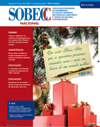Hypothermia in patients undergoing cesarean section
Keywords:
Cesarean Section, Hypothermiia, Perioperative care, Nursing.Abstract
The objective was toexamine the body temperature ofpatientsundergoing cesarean section, as well astheir demographic and clinical variables.To this end, we carried out a quantitativestudy, an observational medium-sizedhospital in the state of Sao Paulo. Theresults showed that the average bodytemperature of patients ranged from36.5°C to 36.6°C during the anesthetic-surgical procedure that lasted an averageof58.5 minutes. In the admission into thePost-Anesthesia 16 (72.7%) patients were normothermic and six (27.2%) were withmi Id hypothermia (tyrnpanic temperaturelower than 36°C). The maximum stay inthe recovery was 150 minutes, averaging80 minutes. We conclude that, in themajority, undergone patients of shortduration surgery under spinal anesthesiawere maintained normothermic during thecourse of anesthetic-surgical procedureand post-anesthesia recovery.
References
Pagnocca ML. Tal Ei, Dwan JL.Controle de temperatura em interven-ção cirúrgica abdominal convencional:comparação entre os métodos de aque-cimento por condução e condução asso-ciada à convecção. Rev Bras Anestesiol. 2009;59(1):56-65.
Association ofPeriOperative RegisteredNurses. Perioperative standards andrecommended practices. Derivei-,2009. Recommended practices for theprevention of unplanned perioperativehypothermia; p491 -504.
Sessler DI. Perioperative heat balance.Anesthesiol. 2000;92(2):578-96.
Buggy DJ, Crossley AW. Thermo-regulation, mild perioperative hypother-miaand postanaesthetic shivering. Br 1Anaesth. 2000:84(5):615-28.
Lenhardt R. Monitoring and therrnalmanagement. Best Pract Res CliiiAnaesthesiol. 2003; 17(4):5 69-8 1.
Bicalho GP, Castro CHV, CruvinelMGC, Bessa iunior RC. Sudorese profusa
e hipotermia após a administração demorfina por via suharacnóidea. Rev BrasAnestesiol. 2006;56(1):52-6.
Poveda VB, Piccoli M, Galvão CM,Sawada NO. Métodos de prevençãoe reaquecimento do paciente para operi-operatório. Rev Eletrônica Enferm.2005;7(3):266-72.
Poveda VB. 1-lipotermia no períodointra-operatório [tese]. Ribeirão Preto:Escola de Enfermagem de Ribeirào Preto,Universidade de São Paulo: 2008.
Faundes A, Ceccatti iG. A Operaçãocesárea no Brasil: incidências e tendências,causas, conseqüências e propostas deação. Cad Saúde Pública. 1991;7(2):150-73.
Oliveira CHS. Monitorização datemperatura. Rev Bras Anestesiol1992;42(1):79-84.
Yazlle MEHD, Mendes MC, PattaMC, Marcolin AC, Azevedo GDIncidências de cesáreas segundo fontede financiamento da assistência ao partoRev Saúde Pública. 2001;35(2):202-06
Tramontini CC, Graziano KU. Controle da hipotermia de pacientescirúrgicos idosos no intra-operatório:avaliação de duas intervenções deenfermagem. Rev Lat-Am Enferm. 2007:1 5(4):626-3 1.
Gotardo iM. Galvão CM. Avaliaçãoda hipotermia no pós-operatório ime-diato. Rev RENE. 2009.10(2):1 13-21.
Leslie K, Sessler Dl. Perioperativeliypotherniia in the high-risk surgicalpatient. Best Pract Res Clin ,Anaesthesiol.2003:1 7(4):485-98.
Kurz A. Therrnal care in the peri-operative period. Best Pract Res ClinAnaesthesiol. 2008;22(1):39-62.
Bernardis RCG, Silva MP, GozzaniiL, Pagnocca ML, Mathias AST. Usoda manta térmica tia prevenção dah ipoterm ia intra-operatória. Rev BrasAnestesiol. 2009;55(4):421-26
American Society of PerianesthesiaNurses. Clinical guideline for theprevention of unplanned perioperativehypothermia. 1 Perianesth Nurs.2001;16(5):305-14.
Downloads
Published
How to Cite
Issue
Section
License
By publishing in Revista SOBECC, authors retain the copyright of their article and agree to license their work using a Creative Commons Attribution (CC BY 4.0) International Public License, thus accepting the terms of this license. The CC BY 4.0 license allows others to distribute, remix, adapt, and create from the published article, even for commercial purposes, provided they give due credit to the creators of the work (authors of the article).
The authors grant to Revista SOBECC the right of first publication, to identify itself as the original publisher, and grant to the journal a non-exclusive license to use the work in the following ways: (1) to sell and/or distribute the article in hard copies and/or in electronic format; (2) to distribute parts and/or the entire article in order to promote the journal through the internet and other digital and printed media; (3) to record and reproduce the article in any format, including digital media.
With this license, authors can enter into separate contracts for non-exclusive distribution of the article (e.g., publishing in an institutional repository or as a book chapter), with acknowledgement of authorship and initial publication in Revista SOBECC. Authors are encouraged to publish and distribute their work online after publication in the Revista SOBECC, as this can increase the article's visibility and impact.
In line with the journal's policies, each published article will be assigned a CC BY 4.0 license, which will be visible on the abstract page and in the PDF of each article with the respective link to the license terms.











